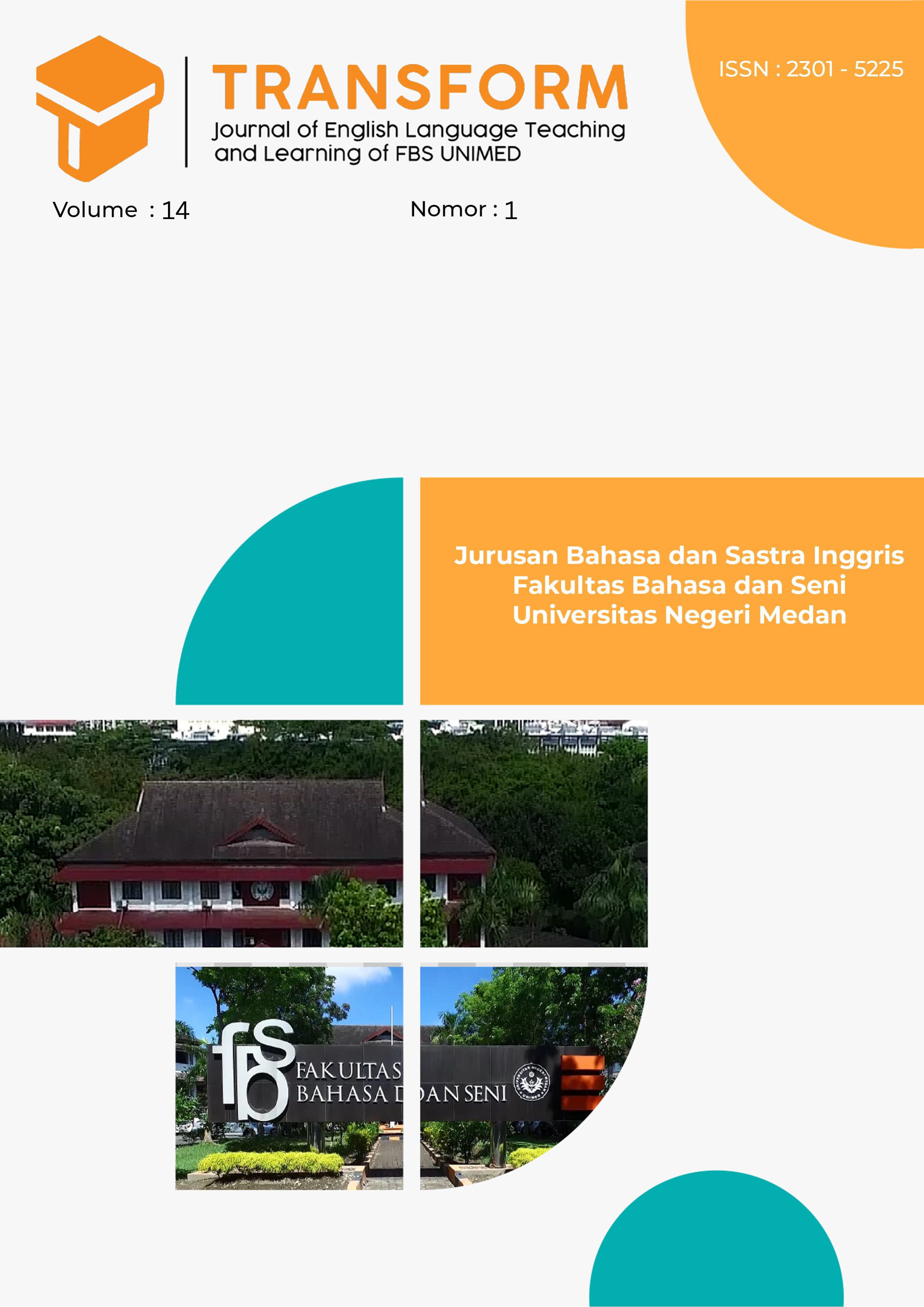The Transformation of Intrinsic Elements in The Adaptation of The Viscount Who Loved Me into TV
DOI:
https://doi.org/10.24114/tj.v14i1.67335Keywords:
Adaptation, Myth, Ideology, Motives, Novel Into TV SeriesAbstract
This study analyzes the transformation of intrinsic elements in The Viscount Who Loved Me novel into the TV series entitled Bridgerton Season 2 by Shondaland through the adaptation theory by Linda Hutcheon. Transformation in the adaptation process leads to the ideology contained in novel and TV series. Mythology by Roland Barthes is used to uncover the ideology behind the adaptation, and it will bring us to the motive of the adaptation. The data are in intrinsic elements such as character, characterization, and plot were taken from the texts in The Viscount Who Loved Me and the TV Series Bridgerton Season 2. The result of this study shows that there are differences in ideologies. In the novel, the ideologies are filled with patriarchy and social class, while in the TV series they focus on American values, feminism, and liberalism. These ideologies reflect the motives behind the adaptation, which are cultural capital and economic lure.References
Badinjki, P. T. (2019). Stereotypical Gender Roles and New Construct of Marriage in Pride and Prejudice. International Journal on Studies in English Language and Literature, 7(1), 43–47. DOI: 10.20431/2347-3134.0701005
Barthes, R. (1957). Mythologies. The Noonday Press.
Bejanyan, K., Marshall, T. C., & Ferenczi, N. (2014). Romantic ideals, mate preferences, and anticipation of future difficulties in marital life: A comparative study of young adults in India and America. Frontiers in Psychology, 5(1), 1–11. DOI: 10.3389/fpsyg.2014.01355
Betts, C. (2015). Women and Marriage in the Georgian and Regency Period. https://www.charlottebetts.com/women-and-marriage/
Budgeon, S. (2015). Individualized femininity and feminist politics of choice. European Journal of Women’s Studies, 22(3), 303–318. DOI: 10.1177/1350506815576602
Christianson, M., Teiler, Å., & Eriksson, C. (2021). “A woman’s honor tumbles down on all of us in the family, but a man’s honor is only his”: young women’s experiences of patriarchal chastity norms. International Journal of Qualitative Studies on Health and Well-Being, 16(1). DOI: 10.1080/17482631.2020.1862480
Denscombe, M. (2010). The Good Research Guide: for small-scale social research projects (4th ed.). Open University Press.
Grace, M. (2016). Courtship and Marriage in Jane Austen’s World. White Soup Press. https://www.everand.com/read/322517405/Courtship-and-Marriage-in-Jane- Austen-s-World-Jane-Austen-Regency-Life
Holtug, N. (2021). The Politics of Social Cohesion: Immigration, Community, and Justice, written by Nils Holtug. In Journal of Moral Philosophy (1st Ed, Vol. 20, Issues 5–6). Oxford University Press. DOI: 10.1093/oso/9780198797043.001.0001
Huang, X. (2019). Understanding Bourdieu - Cultural Capital and Habitus. Review of European Studies, 11(3), 45. DOI: 10.5539/res.v11n3p45
Hutcheon, L. (2006). A theory of Adaptation. Routledge.
Kane, K. (2012). Courting and Marriage in the Regency by Cheryl Bolen. Regency Fiction Writers. https://regencyfictionwriters.org/courting-and-marriage-in-the-regency-by- cheryl-bolen/
Krause, S. R. (2014). The Liberalism of Love [Review of Political Emotions: Why Love Matters for Justice, by M. C. Nussbaum]. The University of Chicago Law Review, 81(2), 833–849. http://www.jstor.org/stable/23762377
Putra, R. T. (2023). Radical Feminist and Interpretative Theories of Woman: Woman Career and Marriage Preparation. 25(1), 2023. DOI: 10.22373/jms.v25i1.17295
Reynolds, D. (2022a). ‘Bridgerton’ creator Chris Van Dusen says queer cruising influences
series. Q Voice News. https://qvoicenews.com/2022/03/29/bridgerton-creator-chris- van-dusen-says-queer-cruising-influences-series/
Reynolds, D. (2022b). How Bridgerton Was Inspired by Its Gay Creator’s Rainbow Family. OUT. https://www.out.com/print/2022/3/25/how-bridgerton-was-inspired-its-gay- creators-west-hollywood-family
Smith, N. (2022). Bridgerton Season 2 Breaks Record to Become the Most Popular English Language Series on Netflix. Forbes. https://www.forbes.com/sites/nashasmith/2022/04/19/bridgerton-season-2- breaks-record-to-become-the-most-popular-english-language-series-on-netflix/
Taylor, E. (2021). BREAKING UP WITH PURITY CULTURE. https://www.onewomanproject.org/religion/breaking-up-with-purity-culture
Tonsing, J. C., & Tonsing, K. N. (2019). Understanding the role of patriarchal ideology in intimate partner violence among South Asian women in Hong Kong. International Social Work, 62(1), 161–171. DOI: 10.1177/0020872817712566
Valentini, V. (2020). Get to Know the Brains Behind Shondaland’s ‘Bridgerton’ Series, Showrunner Chris Van Dusen. Shondaland. https://www.shondaland.com/shondaland- series/shondaland-inventing-anna/a34860495/bridgerton-showrunner-chris-van- dusen/
Vickery, A. (1993). Golden Age to Separate Spheres? a Review of the Categories and Chronology of English Women’S History. The Historical Journal, 36(2), 383–414. DOI: 10.1017/S0018246X9300001X
Downloads
Published
How to Cite
Issue
Section
License
Copyright (c) 2025 Sari Nur Rizki Fitria

This work is licensed under a Creative Commons Attribution-ShareAlike 4.0 International License.
Authors who publish with this journal agree with the following terms:
- Authors retain copyright and grant the journal right of first publication with the work simultaneously licensed under a Creative Commons Attribution License that allows others to share the work with an acknowledgment of the work's authorship and initial publication in this journal.
- Authors are able to enter into separate, additional contractual arrangements for the non-exclusive distribution of the journal's published version of the work (e.g., post it to an institutional repository or publish it in a book), with an acknowledgment of its initial publication in this journal.
- Authors are permitted and encouraged to post their work online (e.g., in institutional repositories or on their website) prior to and during the submission process, as it can lead to productive exchanges, as well as earlier and greater citation of published work (See The Effect of Open Access).
- This work is licensed under a Creative Commons Attribution-ShareAlike 4.0 International License.








